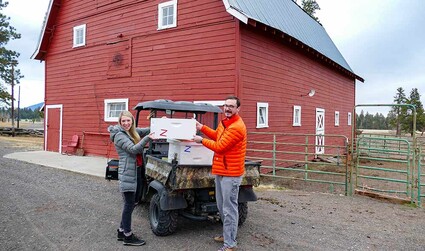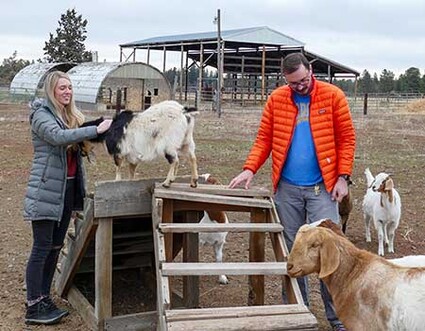Iconic Sisters ranch pursues regenerative agriculture
Last updated 3/16/2021 at Noon
Regenerative farming and ranching are fast becoming mainstream — and one of Sisters’ most iconic ranches is heading at full steam into the movement.
Under regenerative practices, agriculture goes beyond sustainable. Regenerative agricultural methods seek to add to the soil through a self-nourishing ecological system. It’s a closed-loop system that doesn’t halt humans’ impact on the environment — but reverses it.
Regenerative farming focuses on restoring soils that have been degraded by industrial, agricultural systems. Its methods promote healthier ecosystems by rebuilding soil organic matter through holistic farming and grazing techniques.
In essence, regenerative agriculture practitioners let nature do the work. And nature is doing the work on the Lazy Z Ranch.
At one time, the Lazy Z was 1,400 acres stretching across both sides of Highway 20. It has had numerous owners, some of whom have left an historical imprint on Sisters. In 2003, then owner David Herman, who introduced the iconic metal art of running horses, divided the property into 13 parcels ranging from 4.7 to 251 acres and placed nine for sale.
On the north side of Highway 20, in between Hawk’s Haven Reserve and R&B Ranch is the 83-acre “homestead” property of the original Lazy Z founded in the 1880s by early Oregon settler Alfred Cobb. R&B’s parcel is 540 acres and Marleen and Bruce Rognlien’s Hawk’s Haven is 90 acres. Marleen’s family was one in the string of Lazy Z owners in its 135-plus year history.
It is the 83 acres that today is the “official” Lazy Z Ranch, distinguishable from the more generic Lazy Z Property, which is what is generally referenced when driving past the various parcels. The Ranch consists of a 5,900-square-foot custom home, a landmark 100-year-old Dutch barn, painted red of course, an 80-year-old bunkhouse, two ponds, a pole barn, and two steel Quonset buildings.
Last June, John and Renee Herman (no relation to Dave Herman) purchased the Ranch. The Hermans relocated from California with their 5- and 3-year-old children and set about their vision to remake the ranch into a model for regenerative agriculture.
Renee is a marriage and family therapist practicing in Redmond. John, once a youth pastor and administrator of a Seattle homeless shelter, is a meadmaker/brewer, educator, and community activist.
The vision for regenerative ranching is catching on in Sisters.
Emily Payne of AgFunder Network notes: “Soil organic matter is plant or animal tissue in the process of decay. While most soils are only two to 10 percent soil organic matter, this plays a vital role in soil health. Each one-percent increase in soil organic matter helps soil hold 20,000 gallons more water per acre. And heightened water holding capacity means crops are more resilient through times of drought or heavy rain. By maintaining surface residues, roots, and soil structure with better aggregation and pores, soil organic matter reduces nutrient runoff and erosion, as well.
“And the healthier the soil, the healthier the crop. When plants have the nutrients and roots systems they need to thrive, they build compounds to help protect against insects and disease. There is also growing evidence that a healthy soil microbiome full of necessary bacteria, fungi, and nematodes is more likely to produce nutrient-dense food, promoting better human health. Regenerative farming practices boost soil health through a variety of techniques.”
These are the practices of neighboring Sisters Cattle Co. under the stewardship of 34-year-old Hobbs Magaret, who has improved 200 acres of grazing land in Sisters.
Magaret says, “Other cattle companies favor the cattle at the expense of the soil. We work to achieve harmony of the two.
“Moving the cattle frequently and grazing densely creates a herd effect, mimicking massive ancient herds, which is lost with conventional grazing,” said Magaret. “High density/short duration grazing takes carbon from the atmosphere and stores it in the soil. Conventional grazing typically releases more carbon than it stores.”
Diverse forage means regeneratively managed pastures containing more nutrients per bite translate to more nutrients per pound of beef.
The Hermans’ vision extends further. They have a deep sense of community and are eager to share their property and ethos with likeminded groups. At the moment they engage in work with bees (pollinating), goat tending and horse boarding. They soon hope to have community partners for the production of honey, mead, berries (u-pick-um), flowers, pumpkins, and produce for local farm stands and markets.
No doubt that Sisters will find itself more visible in the emerging regenerative ag movement with The Lazy Z likely at the forefront.
Even if you don’t want to get any dirt under your nails, you can still enjoy The Lazy Z Ranch via its vacation rental business. The old bunkhouse and the main, five-bedroom home are available to rent via Airbnb.














Reader Comments(0)